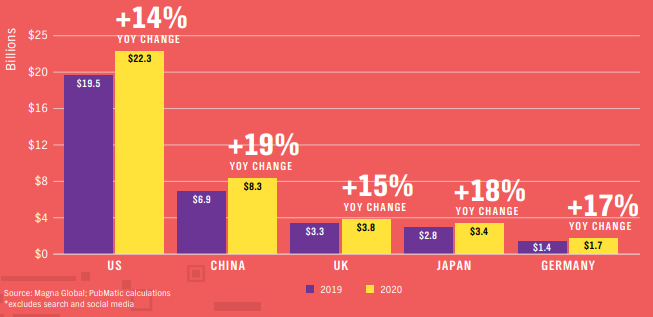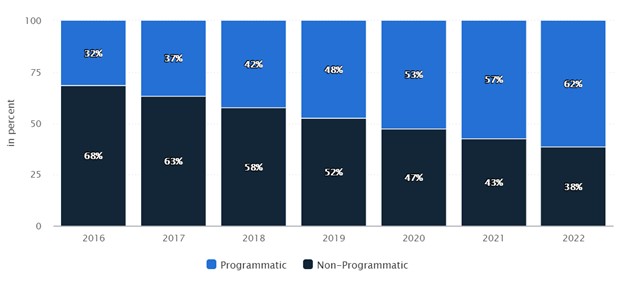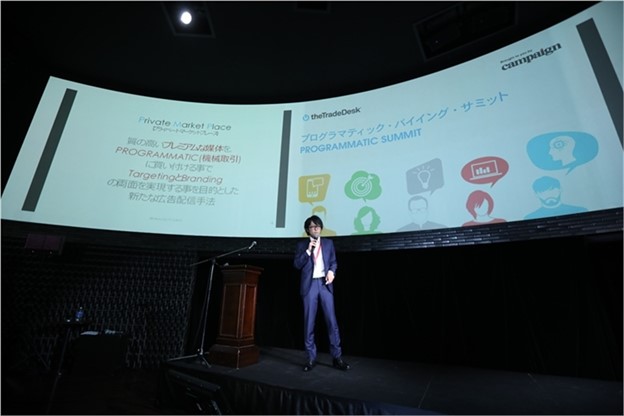Successfully catching the consumer’s attention in today’s digital world is no easy job. A solution to this problem is programmatic advertising. Programmatic ad buying has been a game-changer in online advertising and can help you in this daunting task.
Programmatic advertising is the use of software and algorithms to purchase digital display space. As new digital technology is being introduced and embraced by the customers, the rules of brand engagement are changing.
To reach audiences wherever they are, brands increasingly rely on programmatic buying to deliver highly relevant, effective, and measurable ads. The changes in which audiences consume content and the customer landscape has laid the foundation for the extreme interest in programmatic advertising.
Particularly in Japan, there has been a boom in using programmatic advertising in recent years. Although traditional media in advertising is still widely used, the industry has geared towards programmatic advertising. In fact, about 6.2 billion US dollars of the digital ads budget in Japan was spent on programmatic between 2019 and 2020.

Source: https://pubmatic.com/wp-content/uploads/2019/12/2020-Global-Digital-Ad-Trends.pdf
In addition, it has been estimated that programmatic advertising in Japan will grow by 18 percent year on year in the third quarter of 2020 up to the 2nd quarter of 2021.
What is Programmatic Advertising?
Essentially, programmatic ad buying is a way for you to reach the target audience you wish to show your advertising to. It also allows you to tailor a specific message for a target audience by using audience data and insights from different sources to help you show highly relevant ads at the right time and in the right place.
To do this, programmatic ad buying uses software to buy digital advertising space. Programmatic advertising spans through different platforms, such that any format and any channel can be accessed programmatically, including mobile, desktop, table, audio, digital outdoor and connected television.
Unlike the traditional method that includes requests for proposals, tenders, quotes, human negotiation, and manual insertion orders, programmatic advertising uses machines and algorithms to purchase display space. With this method, we use software to automate the buying, placement, and optimization of media inventory.
This automation makes transactions more efficient and effective as it makes the process of media buying faster and easier. It also helps you deliver far more precision and personalization of messaging and media, thus making your campaigns more efficiently targeted.
“So how does it work?” You may ask. Imagine a loading webpage. This webpage has a designated space for advertisement. Information gathered about the user and the context of the site being loaded exchange and a suitable ad will show up. This space gets auctioned off to the highest bidder, and the exchange places their ad in the space. Platforms do these processes in milliseconds with no seeming disadvantages to page load time or user experience. Using programmatic advertising for your digital advertising campaigns has a lot of benefits. Advantages in programmatic ad buying include:
- Helping you make data-driven decisions in purchasing ads;
- Saving money and time;
- Allowing for better targeting towards potential customers across different devices.
There are two main categories of programmatic advertising: Programmatic Direct, and Real Time Bidding (RTB). Programmatic Direct involves buying display space programmatically in advance, based on a specific number of required impressions and audiences.
RTB is the automated process of purchasing ad space in real-time by bidding according to the target audience you wish to reach.
Programmatic Advertising Scene in Japan
We cannot deny the newfound popularity of programmatic advertising in Japan. Even though traditional advertising still serves as an effective medium for certain forms of campaigns in Japan, the way the industry works is adapting towards programmatic advertising.
Programmatic generated 37 percent of digital advertising revenue in the year 2017. This year, that split is forecasted to increase to 53 percent, and it is estimated that by 2022, 62 percent of revenue will be attributed to programmatic.

Source: https://www.statista.com/outlook/216/121/digital-advertising/japan#market-revenueProgrammatic
Japan’s once budding programmatic market accounted for over $1 billion dollars in digital ad spend in 2017, in comparison with $10 million in 2013–one of the highest growth rates in the world. Today, the country ranks as the top 4 country with the highest programmatic digital ad spend in the world
A study conducted by ExchangeWire and OpenX states that within their 200 media survey respondents in 2019, over one third (33.6%) said that they have increased investment by 25 to 74 percent from the previous year while 13.9% of the surveyed professionals said that they have increased investments by over seventy-five percent.

Photo source: https://www.campaignasia.com/article/japans-whirlwind-adoption-of-programmatic/445290
There are several key factors that have led to the explosion of programmatic advertising in Japan. One factor is the digital advertising market’s priority on high standards of accountability.
Programmatic advertising’s ability to provide simple, visible ROI is in line with this desire for transparency. In addition, programmatic advertising allows brands to buy a display space that meets their specific criteria for targeting and business aim, and enables them to monitor those objectives and have a clear picture of campaign performance and resource allocation.
Programmatic strengthens the trust between brands and agencies resulting in investments needed for the digital advertising industry to burgeon. By being able to provide transparency on ROI, programmatic advertising serves as a catalyst for Japan’s evolution to digital advertising dominance.
The country’s keen interest in innovation has also paved the way for this approach. Advertising platforms, TV, and mobile serve as favorable opportunities for programmatic growth. Specifically, mobile internet has grown consistently with about an 80 percent penetration rate in 2019, and is expected to rise higher in the following years.
In addition, mobile is expected to generate 40 percent of total digital advertising revenue by 2022. Moreover, a study conducted by PricewaterhouseCooper (PwC) forecasted that the mobile programmatic market will reach $2.54 billion by 2020.
The upcoming Olympic Games to be hosted by Japan and held in Tokyo in 2020 can help the digital advertising market to grow substantially. For the longest time, the Olympics has served as an avenue for brands to show off their products and services to infiltrate new markets and strengthen their reputation.
It is not difficult to imagine the impacts that this event will have on programmatic advertising, given that the upward trend of the market continues.
Even though Japan’s programmatic advertising industry is expanding, the portion of ad spend is still slightly lower than other advanced markets such as the USA and China.
Nevertheless, PwC notes that Japan’s programmatic segment is significantly more developed than the rest of Asia Pacific. One reason behind this is that many brands are still starting to understand its advantages and have only begun to tap the power of programmatic to increase the range, relevance, and impact of advertising.
The Future of Programmatic Advertising in Japan
To sum it up, programmatic advertising empowers brands and marketers to be more effective in delivering their message to their target audience, to reach the most desirable markets and demographics, and to open more doors and discover new opportunities through gathered data.
Programmatic advertising in Japan is steadily growing. However, Japan has only begun to realize the advantages and relevance of programmatic.
To get the upper hand, marketers need to recognize the benefits programmatic technology has to offer, which traditional media does not, such as data-driven prospects, higher yield for publishers, and measurable evaluations. However, learning how to take advantage of such capabilities will mean following the example of other markets.
Marketers can implement the most effective techniques and systems to boost their programmatic expertise and hoist up Japan’s global standing by emulating early adopters as their model. As the number of platforms continues to expand, there will be more chances for marketers to make the most out of their experience: use their skills and abilities to avoid programmatic drawbacks, improve strategies, and maintain high quality.
It is undeniable that Japan’s programmatic has begun to flourish and prosper and that the succeeding years will bring a surge in automated efficiency. These are exciting times for the programmatic advertising market in Japan. For those who want to keep up with the trend, it is ideal for you to be placed in the forefront.
This means preparation will be paramount if marketers desire to ascertain programmatic profitability at present as well as in the future.
We, at Info Cubic Japan, can help you jump on the bandwagon of programmatic advertising and employ a more rewarding ad optimization strategy.
Featured image by Ana Rodriguez
